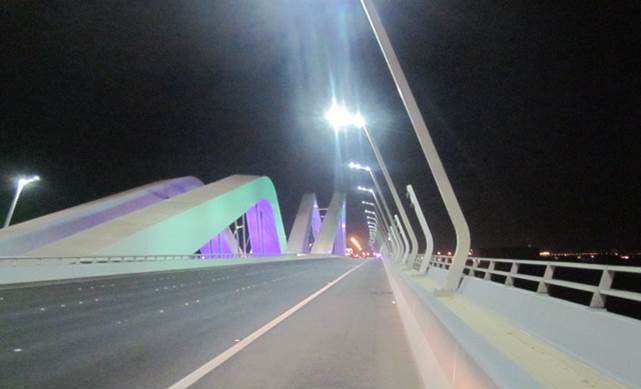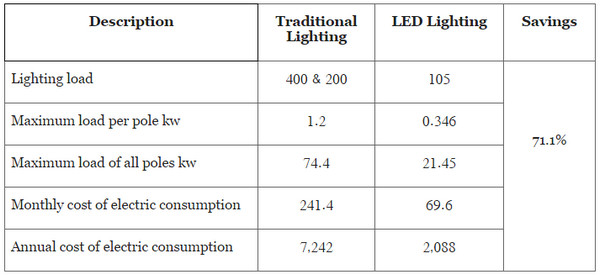The Abu Dhabi City Municipality has accomplished the project of replacing traditional lighting on the Sheikh Zayed Bridge by an LED lighting system.
The project is part of the lighting strategy aimed at nurturing a sustainable environment compatible with the vision, and directions of the Municipal System and the Abu Dhabi City Municipality aimed at implementing the standards of sustainability and conservation of electric power set out since 2012 by adopting the highest international standards of or sustainability of projects in accordance with Abu Dhabi Plan 2030.
 |
|
Sheikh Zayed Bridge in Abu Dhabi after the LED upgrade. (The Abu Dhabi City Municipality) |
The replacement of conventional lighting on the Sheikh Zayed Bridge by LED lights echoes the commitment of the Abu Dhabi City Municipality to implement the lighting strategy on roads, bridges, underpasses and public areas.
The maintenance & operation team internal roads lighting network and public areas at the Infrastructure and Municipal Asset Sector, has replaced the traditional lights of the Sheikh Zayed bridge by LED lights. The main objectives of the project were to implement the new lighting strategy, improve the entrance of Abu Dhabi city, save about 77% of power consumption. Moreover, the new system uses environment-friendly devices that contain no mercury of dangerous materials.
Among the key features of the project is the improvement of the lighting performance on the bridge such that its features will look more elegant and bright with impressive colors unlike before. It also contributes to a reduction of annual maintenance costs by not less than 80%.
As far as the traffic safety benefits achieved by the project, the use of LED lights improves traffic safety due to the clearer visibility on road, and the lack of disturbing glare. The new lighting system is covered by 10-year warranty as it has minimal faults, and maintains the level of the required light intensity. The use of LED lights cuts maintenance works by 80% compared to previous lighting and maintenance is only restricted to the feeder network of lighting poles, and emergency works to ensure that the new systems are compatible with the standards of the Abu Dhabi City Municipality.
In a comparative study between the new and old systems, the Municipality indicates that the new system achieves savings of about 7101% and maintains excellent levels of power consumption reduction rates as shown in the table below:
 |
|
(Source: The Abu Dhabi City Municipality) |
Traditional Lighting
It is worth mentioning that, as part of the lighting strategy, the Municipality has carried out several projects including the sustainable lighting project in East Sector - Zone 48, and West Sector – Zone 33. Accordingly, the total capacity has reduced from 54 to 12 kw thanks to reducing the electric capacity of lighting systems from 477 watts to 108 watts. The project of replacing traditional lighting with lighting aligned to sustainability standards in West Sector – Zone 33, has saved more than 62% of annual consumption. The electric capacity in internal roads using lighting devices has dropped from 477 watts to 180 watts, and from 1160 watts to 440 watts in the highway.
The traditional lighting in Abu Dhabi subways has been replaced with LED lighting devices, resulting in an average reduction in consumption of 56%. The total capacity has reduced from 110 to 67 thanks to replacing the tunnel spot lighting devices, reducing capacity from 70 watts to 35 watts, besides replacing the ceiling lighting, bringing capacity down from 100 watts to 68 watts.
The project of replacing traditional lighting with LED lighting system below bridges in Abu Dhabi include (Passports Bridge, Assaada Bridge, Al Muroor Bridge), has reduced energy consumption by at least 75%.
As part of the sustainability projects of public lighting strategy, Abu Dhabi City Municipality has prepared a Public Lighting Guide in order to disseminate the principles of lighting among all community segments. The Guide also contributes to realizing the sustainability principles in implementing public lighting works, and will help the Municipality, consultants and individuals in designing lighting.













